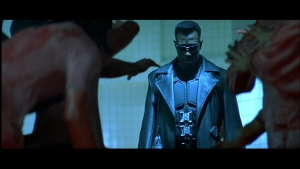(courtesy of guest reviewer – GORELORD)
Before I get going with my review, I want to make something clear to horror fans who are new to the genre. There are two movies in the world of flesh feasting flicks titled NIGHT OF THE ZOMBIES. I want to let readers know right now that this is NOT the 1983 Italian made zombie/cannibal gore-a-thon directed by Bruno Mattei.
This is the 1981 NIGHT OF THE ZOMBIES and fans of hard to find obscure horror films would likely have a more difficult time tracking down this oddity. Previously know as GAMMA 693 and NIGHT OF THE WEHRMACHT ZOMBIES, this low budget Nazi zombie cheapie was directed by notorious small time horror/exploitation director, Joel M. Reed.
Reed became an infamous name in the trashy horror sweepstakes when he was all but executed by women’s protest groups after he made his most sick, nauseating, and perhaps most entertaining film, Bloodsucking Freaks (1978) (originally known as The Incredible Torture Show). He kept a much lower profile with this, his last film to date, from NMD Film Distributing. On a side note, Reed has been quoted as saying that the company that released Bruno Mattei’s 1983 Night of the Zombies stole the ad campaign for his film. I presume he’s referring to Vestron Video.
Filmed in Munich, Germany and upstate New York, NIGHT OF THE ZOMBIES was backed by producer Lorin E. Price, who appears in the movie as a priest. Unfortunately, Joel Reed and the actors in the film soon discovered that Price had a habit of not coming up with the money he promised. As a matter of fact, the main star of this zombie romp, Jamie Gillis, claims that Price still owes him money for the movie to this very day! Great way to build a reputation in the film industry. Let’s hire this guy.
As I popped my copy into the old VCR I discovered something kind of strange. My print, courtesy of Interglobal Video, has the title Night of the Zombies 2 in the opening credits. The weird thing about it is, this was made a couple of years before the 1983 Night of the Zombies. The only explanation I can come up with for this is that maybe director Reed and Interglobal Video did this to avoid any confusion between the two films. With the amount of alternate titles floating around in the pool of cinematic scum, you just never know.
Among a group of unknowns, one interesting casting choice rises to the top, literally. Porno film superstar Jamie Gillis was chosen to play the main character in what was one of only a handful of legitimate film Gillis had starred in. He had previously appeared in a horror satire called Dracula Sucks (1979), directed by Philip Marshak. He does a pretty nice acting job in this flick, which may surprise a few people.
During the credits we are subjected to German military music and the psychotic ramblings of Adolph Hitler. Hitler’s ugly rant takes away from the camera shots of the beautiful snow covered Bavarian Alps, which is where a lot of the film takes place. Two grave registration officials are camped out somewhere in the Alps. They are searching for the remains of soldiers killed there during a World War II battle between a Nazi SS unit and an American chemical warfare battalion in 1944. Bavarian Police Captain Fleck (played by Ron Armstrong) insists that a battle never took place there in 1944, but the villagers claim it did take place. The villagers also claim that the Alps are infested with the living dead. The grave registration officials laugh at the rumors of zombies, but they will soon be wishing they hadn’t.
As the two men get ready to call it a night, they hear the sounds of machine guns blasting in the distance. One of them believes it’s bandits firing the weapons, after Police Captain Fleck had warned the men about them. But the other is positive that those are German machine guns that they’re hearing and goes out to investigate. As he ventures off into the hills, you kind of get the idea that he’s about to be written out of Joel M. Reed’s script. Sure enough we hear a creepy laughter and a gray-faced ghoul dressed in a Nazi SS uniform appears, not to eat, but shoot (!?) the unfortunate victim. The other grave registration official comes out of the tent and soon after he too is shot down by the pasty face soldiers. I guess they weren’t looking for a bite to eat at that time of night.
Among the two bodies a letter in a sealed envelope is discovered, which Police Captain Fleck takes and mails to the address on the front.
We are then taken to an office (looks more like an apartment) where CIA Chief Collins (played by supervising editor Ron Dorfman) gives CIA agent Nick Monroe (played by Jamie Gillis) what he calls a “minimum exposure assignment”. With the countless T&A extravaganza’s that porn king Gillis has been in, I’m not sure he knows what a minimum exposure assignment is. Collins tells Monroe that he is sending him to Munich, Germany and the Bavarian Alps. However, it is not to investigate the deaths of the two grave registration officials, but to recover canisters of a special experimental gas. The gas was lost in the Alps when it was in the possession of the American chemical warfare unit (known as Special Unit C) that battled against a Nazi SS unit. It is known as Gamma 693 (which explains one of the alternate titles) and is a lethal gas that the U.S was going to experiment with on the Germans. Collins instructs Monroe to meet with one Dr. Proud; a biochemist who has developed a deactivating foam that will destroy the effects of the gas. Are you confused yet? Well don’t worry, you will be. Surely you didn’t expect to find any logic in a Joel M. Reed film.
Monroe goes to see the respected biochemist, Dr. Proud (played by Ryan Hilliard). But by the time Proud utters his third or fourth sentence you’ll be questioning his intelligence. With a straight face Proud tells Monroe, “Nick, it’s absolutely imperative that we retrieve that gas as soon as possible. The containers could start leaking any day now.” After hearing that I’m almost positive that there are very few traces of logical plot development in this movie. If the containers of Gamma 693 gas are so deadly, why in the hell didn’t they retrieve them when they were first lost back in 1944??! Dr. Proud goes on to tell Monroe that he was the assistant of the man who first created the gas back during the time of World War II. That would have made him about three years old! Monroe shows very little intelligence as well by barely reacting to the statement. The CIA really have themselves a couple of rocket scientists with these two guys. The gas could kill two million people but don’t worry, these guys are on the case.
Before Monroe and Proud leave for Germany, Nick meets up with CIA Chief Collins, who has a chilling surprise for him. Collins now has the letter that Police Captain Fleck had found among the bodies of the two grave registration officials in the Alps. It turns out that it was written by soldier from World War II Special Unit C to his sister. Collins says that the ink in the letter is fresh. Monroe refuses to believe it, even though he believed that Dr. Proud was a biochemist in World War II.
Monroe arrives in Munich and meets with Dr. Proud at a restaurant. Proud has his niece Susan (played by Samantha Grey) with him, who for no apparent reason is going to the Alps with them. Then in another mind number, Dr. Proud spots a young man in his early twenties who he apparently knows. When Nick asks about the guy, Proud tells him that they were in World War II together! Is this guy on some kind of hallucinogenic or what? Again Monroe brushes it off like Dr. Proud is perfectly normal.
Monroe goes out on his own to some of the local bars to see what he can dig up on the soldiers who disappeared in the World War II battle in the Bavarian Alps. After getting nowhere with the locals and being attacked by a guy who laughs when he’s shot in the stomach, Monroe is followed by a mysterious little man. The man turns out to be a neo-Nazi CIA informer (played by none other than director Joel M. Reed) who tells Monroe about a right wing group in the area comprised of both Americans and Germans. Nick gives the informer a list of names to track down. However, when the informer comes back with a lead, he is stabbed in the back by two men on the street. When Monroe follows up on the small bit of information the informer did give him, he hits yet another dead end. When several other informers are murdered by an unseen killer (one of them is eaten in a camera shop), Monroe gives up on questioning the locals and heads for the Alps along with Dr. Proud and Susan.
When they arrive in the snowy Alps they meet up with Police Captain Fleck and are accompanied to their campsite by a border patrol. The first night of their stay Susan walks off into the wooded hills to do her business. She hears an eerie laughter in the darkness. As she looks around, a blue faced rotting corpse wearing Nazi gear comes at her with a dagger! But just as he’s about to plunge the blade into her, some normal looking American dude wearing a winter coat orders the zombie to leave her alone and stay away from the campsite.
The next day Monroe goes searching around the Alps on snow shoes, looking for the containers of Gamma 693. He stumbles upon stock footage of military vehicles and an army base. He makes his way up to the base and peers through a window. He see’s a man dressing in a United States World War II jacket. Back at the camp Dr. Proud starts to become mysteriously ill. The same night, an unseen killer decapitates Police Captain Fleck while he is sleeping and cooks his torso over a campfire. Someone must have felt like a midnight snack.
Monroe starts to believe the rumors of zombies after Dr. Proud runs into a couple of them and remembers their faces from World War II. They have a habit of battling in the hills at night, so in a ludicrous plot twist Monroe disguises himself as one of the living dead and infiltrates the zombie base! Sitting amongst the zombie soldiers Monroe discovers that Gamma 693 is the reason why these World War II soldiers are still the same age as they were in 1944. The gas prevents them from getting older, but without it they must consume human flesh in order to maintain their appearance. Good thing they have stock farms of captured villagers. And in another outrageous twist, it turns out that the American chemical warfare battalion and the Nazi SS unit that supposedly did battle, actually joined forces to perfect the Gamma 693 gas! Has your brain melted yet?
Back at the camp, the reason behind Dr. Proud’s sickness is revealed when his flesh starts to rot off of his hands and face. It turns out that he was around back in 1944 like he had told Monroe. He stole a canister of Gamma 693 when he was an assistant for the creator of the formula. When the creator found out, Proud had no choice but to kill him. Proud was going to steal the formula but it was lost in a fire. Ever since then Dr. Proud has been forced to eat human flesh in order to survive. Makes sense now, right? I didn’t think so. Dr. Proud tries to eat Susan but Nick shows up and Proud is turned into a skeleton after being sprayed with the deactivating foam.
Monroe goes back to the zombie base with the intention of wiping them out with the foam, but they corner him and give him the choice to either join or be killed. Does Monroe join the zombie legion? Fans of cheesy flicks can sit through this and find out themselves. If you’re a dedicated cheddar head then you’ll probably love it.
This is my first Joel M. Reed film and I can proudly say that he has gained a fan in me. As far as zombie films go, this is probably one of the strangest and most bizarre you will ever find. Low on the usual hardcore zombie gore, but it has enough corny elements to please bad horror buffs. For other films in the Nazi zombie subgenre check out Shock Waves (1975), Zombie Lake (1980), and Oasis of the Zombies (1982). I know this was a long review but this movie deserves it. Spit on crap like Titanic and The Matrix and discover the low budget living dead instead.
![]()
![]()
![]()
![]()

 The Transformers: The Movie is no place to begin your journey through the myriad maze of the Cybertronian Wars. A link between the second and third seasons of its eponymous TV show, The Movie will leave uninitiated peoples confused, annoyed, and potentially hostile to a set of stories that continue to fascinate hardcore fans of this stupid little cartoon. The trauma it caused us and its shinning, brilliant disdain for outsiders makes this the high water mark of 1980s toy commercial animation. Screw you, the film says. This is for the fans. And if you don’t like it, just wait ’til will kill off all the main characters.
The Transformers: The Movie is no place to begin your journey through the myriad maze of the Cybertronian Wars. A link between the second and third seasons of its eponymous TV show, The Movie will leave uninitiated peoples confused, annoyed, and potentially hostile to a set of stories that continue to fascinate hardcore fans of this stupid little cartoon. The trauma it caused us and its shinning, brilliant disdain for outsiders makes this the high water mark of 1980s toy commercial animation. Screw you, the film says. This is for the fans. And if you don’t like it, just wait ’til will kill off all the main characters. Looking back, Gamera’s rebirth was almost inevitable. History repeats itself and the movie industry eats its dead. Inspired by the success of the modern Godzilla films (beginning with 1984’s Godzilla and ending, on a dower, cliffhanger-note in 1995’s Godzilla vs. Destroyah), Daiei brought their own terrible terrapin out of retirement exactly nine months before Godzilla’s (latest) death. In black and white, as I’ve mentioned, Gamera can be somber, dynamic, dark…creepy in his own, lantern-eyed way. But the advent of cheap color film technology was no friend to the Friend to Children Everywhere.
Looking back, Gamera’s rebirth was almost inevitable. History repeats itself and the movie industry eats its dead. Inspired by the success of the modern Godzilla films (beginning with 1984’s Godzilla and ending, on a dower, cliffhanger-note in 1995’s Godzilla vs. Destroyah), Daiei brought their own terrible terrapin out of retirement exactly nine months before Godzilla’s (latest) death. In black and white, as I’ve mentioned, Gamera can be somber, dynamic, dark…creepy in his own, lantern-eyed way. But the advent of cheap color film technology was no friend to the Friend to Children Everywhere.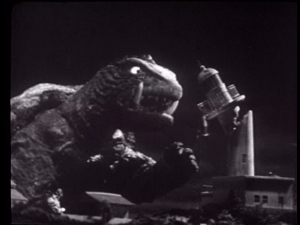 Though he began life as a humble Godzilla rip-off in a land and time glutted with them, Gamera would come to symbolize everything that went so horribly wrong with the Golden Age of daikaiju cinema. But let us not tell sad stories about the death of kings just yet…like his more famous cousin/industrial competitor, Gamera began life as a serious apotheosis of the paranoia and insecurity of his age. But even here, at the beginning, we can see his creators at Daiei Studios sowing the seeds of their creation’s destruction.
Though he began life as a humble Godzilla rip-off in a land and time glutted with them, Gamera would come to symbolize everything that went so horribly wrong with the Golden Age of daikaiju cinema. But let us not tell sad stories about the death of kings just yet…like his more famous cousin/industrial competitor, Gamera began life as a serious apotheosis of the paranoia and insecurity of his age. But even here, at the beginning, we can see his creators at Daiei Studios sowing the seeds of their creation’s destruction. This film might’ve had a chance, but I doubt it. Love may be stronger than death, but the love of sequels is stronger than common sense, particularly in Hollywood. So I’m not surprised this film turned out to be a pale imitation of
This film might’ve had a chance, but I doubt it. Love may be stronger than death, but the love of sequels is stronger than common sense, particularly in Hollywood. So I’m not surprised this film turned out to be a pale imitation of 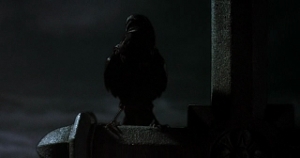 I have a confession to make: as a Crow fan from way back. Before the Kitchen Sink Press Author’s Edition, I was there. Before the crappy TV series, I was there. Before Brandon Lee’s untimely and unfortunate death eclipsed almost everything else associated with this film, and the story it contains, I poured over J. O’Barr’s black and white catharsis of a comic. And I loved it. To my teenage mind, this psychopathic little story seemed an expression of love. The kind of mournful, melodramatic love adolescents, and the perpetually adolescent at heart, believe is really all there is.
I have a confession to make: as a Crow fan from way back. Before the Kitchen Sink Press Author’s Edition, I was there. Before the crappy TV series, I was there. Before Brandon Lee’s untimely and unfortunate death eclipsed almost everything else associated with this film, and the story it contains, I poured over J. O’Barr’s black and white catharsis of a comic. And I loved it. To my teenage mind, this psychopathic little story seemed an expression of love. The kind of mournful, melodramatic love adolescents, and the perpetually adolescent at heart, believe is really all there is. Most critics began their writeups of this film with the elementary and idiotically middle-minded question: “What if you woke up [in our main character’s situation]?” Well no surprise, me: I’d freak out, find a hole to crawl in, and stay there. As would you, fictional meta-critic I made up for this intro. But then, we’re not the protagonist of Dark City. Or are we really? And if not, then just what are we? The sum of our experiences? Take those from us and what’s left? Emotions? Sense impressions? Souls? Some interior sense of justice and injustice? Is there anything within our beings that makes us uniquely us? What is it, then? And when will some anonymous Chosen One rise from out the bewildered herd to educate us and our body-snatching, pale-faced, alien masters?
Most critics began their writeups of this film with the elementary and idiotically middle-minded question: “What if you woke up [in our main character’s situation]?” Well no surprise, me: I’d freak out, find a hole to crawl in, and stay there. As would you, fictional meta-critic I made up for this intro. But then, we’re not the protagonist of Dark City. Or are we really? And if not, then just what are we? The sum of our experiences? Take those from us and what’s left? Emotions? Sense impressions? Souls? Some interior sense of justice and injustice? Is there anything within our beings that makes us uniquely us? What is it, then? And when will some anonymous Chosen One rise from out the bewildered herd to educate us and our body-snatching, pale-faced, alien masters?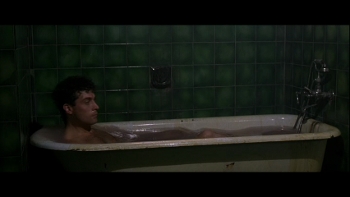 At Dark City‘s opening, we know as little as our protagonist (Rufus Sewell), who wakes in lukewarm hotel bathtub with no memory of who he is or how he came to be there. The driver’s license in his pocket says his name is John Murdoch. A mysterious phone call from Kiefer Sutherland, and the dead hooker on the floor with the Fibonacci spirals etched into her flesh, tell him some Five Alarm shit is going on. A hasty exit might be the most pragmatic course of action. We follow John’s aimless wanderings around the titular City for several scenes…until a gang of strange men in black start to chase after him. Since none among them is Will Smith, John makes the safe assumption that they must be Evil . Chopping one open reveals this to be a prudent assumption. Hell, they aren’t even human. But if the strange, telekinetic powers John manifests during this initial chase scene are any indication, Our Protagonist ain’t exactly Joe Normal either.
At Dark City‘s opening, we know as little as our protagonist (Rufus Sewell), who wakes in lukewarm hotel bathtub with no memory of who he is or how he came to be there. The driver’s license in his pocket says his name is John Murdoch. A mysterious phone call from Kiefer Sutherland, and the dead hooker on the floor with the Fibonacci spirals etched into her flesh, tell him some Five Alarm shit is going on. A hasty exit might be the most pragmatic course of action. We follow John’s aimless wanderings around the titular City for several scenes…until a gang of strange men in black start to chase after him. Since none among them is Will Smith, John makes the safe assumption that they must be Evil . Chopping one open reveals this to be a prudent assumption. Hell, they aren’t even human. But if the strange, telekinetic powers John manifests during this initial chase scene are any indication, Our Protagonist ain’t exactly Joe Normal either.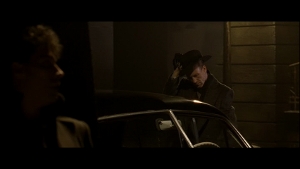 Finding his wife, John learns that not only does he have a wife named Emma (played by Jennifer Connelly – Go, you, Johnny-boy), but that she was unfaithful to him at some point in the past he can no longer recall. She also tells him of his doctor, Daniel Schreber (Kiefer Sutherland), and how a quick sit-down with Dr. Schreber might also be a good idea. John departs to assimilate this. On the one hand, she could be lying. On the other hand, infidelity can turn people into murderous madmen. But John’s not a murderer. Or is he? That dead hooker (and the string of them appearing around the City these past few nights) might be his work…or the work of those “men” he just escaped.
Finding his wife, John learns that not only does he have a wife named Emma (played by Jennifer Connelly – Go, you, Johnny-boy), but that she was unfaithful to him at some point in the past he can no longer recall. She also tells him of his doctor, Daniel Schreber (Kiefer Sutherland), and how a quick sit-down with Dr. Schreber might also be a good idea. John departs to assimilate this. On the one hand, she could be lying. On the other hand, infidelity can turn people into murderous madmen. But John’s not a murderer. Or is he? That dead hooker (and the string of them appearing around the City these past few nights) might be his work…or the work of those “men” he just escaped.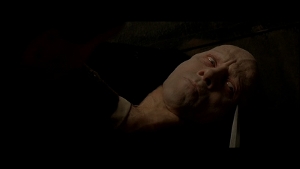 Freaked right the fuck out, John attempts to hide, and finds the good Dr. Schreber not only awake but running around with these “men”, helping them perform experiments on the City’s sleeping population. After some pummeling, Schreber explains that all this…the city, the people in it, John’s memories (or lack thereof)… is the work of what Schreber calls “the Strangers,” alien beings who use our dead as “vessels” and have the ability to alter physical matter through the telepathic machines that run under the City. Built, not on Rock-n’-Roll, but on dreams, populated by kidnapped hordes of long-forgotten origin, the City is a perfect closed system, a vast simulation. Every twelve hours the Strangers shut the whole thing down and “tune” bits of it their whim, including the memories of its ignorant inhabitants.
Freaked right the fuck out, John attempts to hide, and finds the good Dr. Schreber not only awake but running around with these “men”, helping them perform experiments on the City’s sleeping population. After some pummeling, Schreber explains that all this…the city, the people in it, John’s memories (or lack thereof)… is the work of what Schreber calls “the Strangers,” alien beings who use our dead as “vessels” and have the ability to alter physical matter through the telepathic machines that run under the City. Built, not on Rock-n’-Roll, but on dreams, populated by kidnapped hordes of long-forgotten origin, the City is a perfect closed system, a vast simulation. Every twelve hours the Strangers shut the whole thing down and “tune” bits of it their whim, including the memories of its ignorant inhabitants.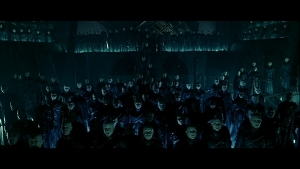 Indeed, Goyer, Dobbs and Proyas have hit upon a story that renders traditional film tropes like characterization less than useless. John Murdoch’s past is not the point of all this, despite its pulling double shifts as both a MaGuffin and a climactic reverser (sorta, kinda, spoiler alert). This in no way discourages the actors from giving their best. William Hurt, for example, is a wonderful gumshoe hot on John’s trail, who for once follows Sherlock Holmes patented method of investigation all the way to its however-improbable conclusion. Connelly, despite ending up a damsel in distress, projects a quiet strength that elevates her lady-in-waiting role to a third dimension. I even believe her tears (and Connelly does has some of the best tears in the biz), just as I believe Sewell’s desperate near-madness as he succeeds in playing the non-character main character that he is.
Indeed, Goyer, Dobbs and Proyas have hit upon a story that renders traditional film tropes like characterization less than useless. John Murdoch’s past is not the point of all this, despite its pulling double shifts as both a MaGuffin and a climactic reverser (sorta, kinda, spoiler alert). This in no way discourages the actors from giving their best. William Hurt, for example, is a wonderful gumshoe hot on John’s trail, who for once follows Sherlock Holmes patented method of investigation all the way to its however-improbable conclusion. Connelly, despite ending up a damsel in distress, projects a quiet strength that elevates her lady-in-waiting role to a third dimension. I even believe her tears (and Connelly does has some of the best tears in the biz), just as I believe Sewell’s desperate near-madness as he succeeds in playing the non-character main character that he is. I don’t really mind the Stranger’s underdeveloped alien-ness. They look and act more-or-less like the vampires they’re meant to remind me of, yet they’re saved from being one-dimension villains by a wonderful turn from Richard O’Brien (know around these parts as Riff-Raff from The Rocky Horror Picture Show) as the aptly-named Mr. Hand. In an attempt to track John down before he wreaks the whole applecart, Mr. Hand volunteers to be imprinted with the very memories John rejected. With gleaming death in his eye, Mr. Hand sets out to ensnare humanity’s only hope with a little unwitting help from Emma and William Hurt’s character, the film’s noir-detective-alike. This bit of movie cat-and-mouse handily pads out the second act while allowing us to step behind the Stranger’s curtain of creepiness. Surprise! They’re not all that different from us, really. No more so than the Morlocks. And once again, that’s okay, because for all their advanced technology they aren’t really the point either.
I don’t really mind the Stranger’s underdeveloped alien-ness. They look and act more-or-less like the vampires they’re meant to remind me of, yet they’re saved from being one-dimension villains by a wonderful turn from Richard O’Brien (know around these parts as Riff-Raff from The Rocky Horror Picture Show) as the aptly-named Mr. Hand. In an attempt to track John down before he wreaks the whole applecart, Mr. Hand volunteers to be imprinted with the very memories John rejected. With gleaming death in his eye, Mr. Hand sets out to ensnare humanity’s only hope with a little unwitting help from Emma and William Hurt’s character, the film’s noir-detective-alike. This bit of movie cat-and-mouse handily pads out the second act while allowing us to step behind the Stranger’s curtain of creepiness. Surprise! They’re not all that different from us, really. No more so than the Morlocks. And once again, that’s okay, because for all their advanced technology they aren’t really the point either.